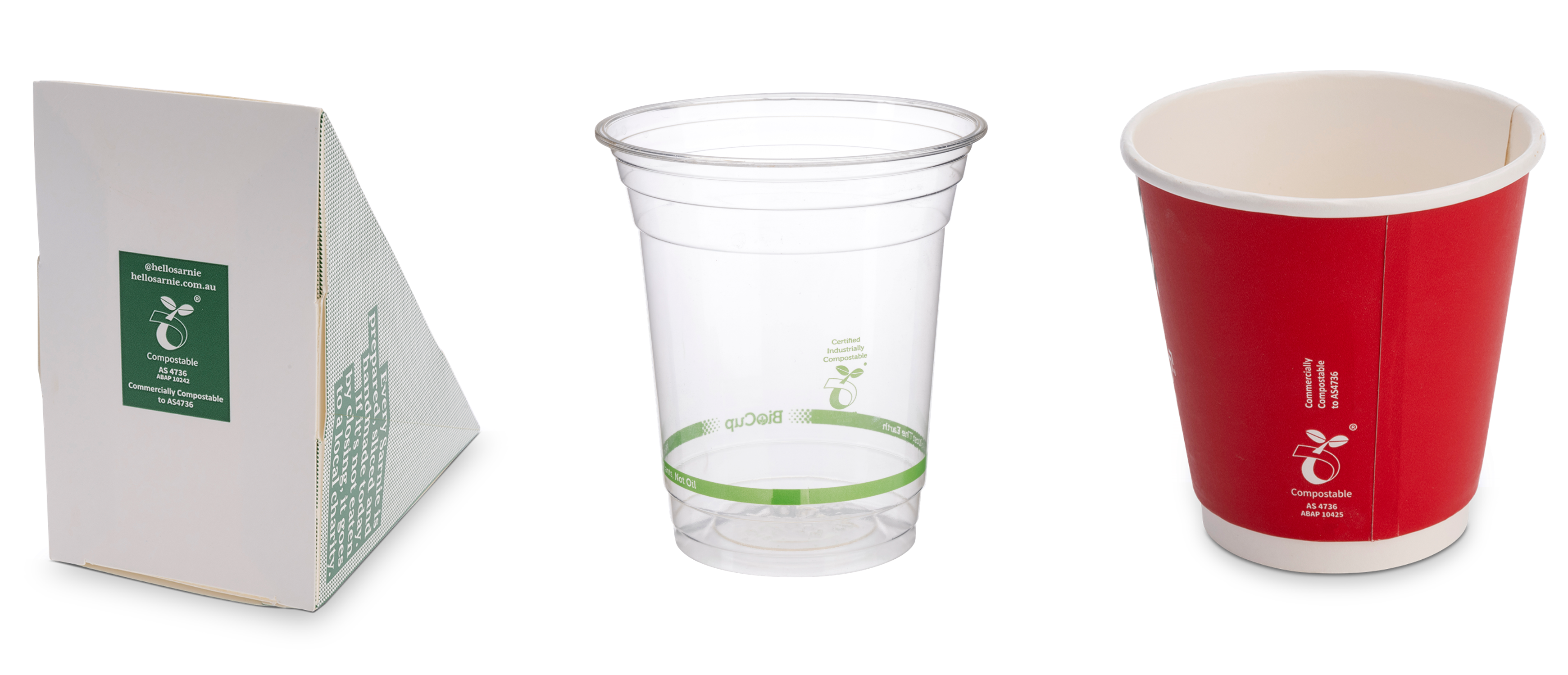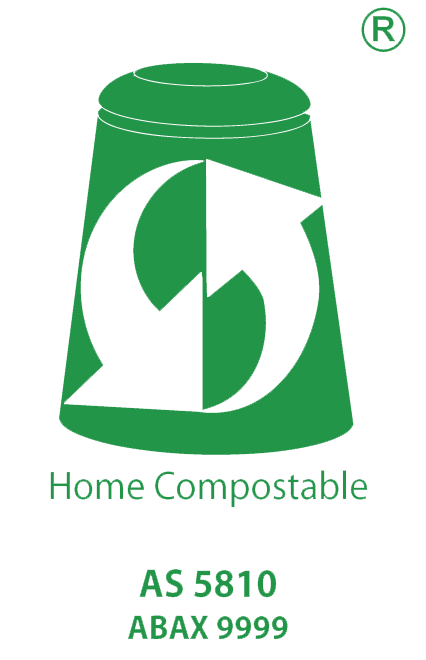The following guide provides information about the labelling requirements for Australian Standard (AS) certified compostable plastic barrier bags, plastic shopping bags, food containers including bowls without lids and beverage containers.
At a glance:
- From 1 September 2024, for an AS certified compostable plastic barrier bag or AS certified compostable plastic shopping bag to be exempt from being a prohibited plastic product, it must be ‘clearly labelled as, or otherwise marked in a manner that indicates that’ the product is home compostable, both home compostable and industrially compostable, or industrially compostable’ (as applicable).
- From 1 March 2026, for an AS certified compostable food and beverage containers, including bowls without lids to be exempt from being a prohibited plastic product, it must be ‘clearly labelled as, or otherwise marked in a manner that indicates that’ the product is home compostable, both home compostable and industrially compostable, or industrially compostable’ (as applicable).
Individual items (bases and lids) must be clearly labelled. Labelling the packaging of items is not sufficient to be compliant with the regulations.
Exemptions:
- AS certified compostable plastic food containers and beverage cups with a capacity of less than 60ml do not need to be labelled.
- AS certified compostable plastic food container lids and beverage cups with a diameter of less than 70mm do not need to be labelled.
Why is labelling required?
Labelling ensures that suppliers, business owners, consumers and receival facilities can easily identify AS certified compostable products and know that, in South Australia, these products are legal and they can be disposed of in green-lidded organics bin systems accepting food and garden organics.
Research completed in 2023 by the Compostable Coalition UK has shown that when compostable packaging is clearly labelled, it is much more likely to be correctly disposed of in the organic bin system ensuring optimal food waste recovery and lower environmental impact.
Certified compostable plastic barrier bags and shopping bags
Since 1 September 2024, for an AS certified compostable plastic barrier bag or AS certified compostable plastic shopping bag to be exempt from being a prohibited plastic product, it must be ‘clearly labelled as, or otherwise marked in a manner that indicates that’ the product is home compostable, both home compostable and industrially compostable, or industrially compostable’ (as applicable).
Certified compostable food and beverage containers
From 1 March 2026, the South Australian regulations require that to be exempt from being a prohibited plastic product, individual AS certified compostable food and beverage containers, including bowls without lids, must be ‘clearly labelled as, or otherwise marked in a manner that indicates that’ the product is home compostable, both home compostable and industrially compostable, or industrially compostable (as applicable). This includes all food containers and their lids, where used for ready-to-eat food and all hot and cold beverage cups and their lids.
What are the wording requirements?
The South Australian regulations do not mandate the use of logos or specific wording, other than the product must be clearly marked with accurate information about its compostability. Businesses need to make a commercial decision on how they choose to label their product, taking into consideration any licensing requirements for certification logos and the Australian Competition and Consumer Commission guidance, Making environmental claims: A guide for business. Using logos in accordance with licencing requirements is encouraged to clearly communicate to the user the best pathway for these materials.
Note that even if a product is labelled compostable, the Environment Protection Authority may still require proof that it is certified in accordance with the legislation (for example, provision of the certification/accreditation provided for that product).
It is recognised that ‘commercially compostable’ rather than ‘industrially compostable’ is the preferred term used by Australasian Bioplastics Association who licences the use of the seedling logo on products that are certified to AS 4736-2006 standard Biodegradable plastics—Biodegradable plastics suitable for composting and other microbial treatment (AS 4736-2006).
Labelling products certified to AS 4736-2006 as either ‘industrially compostable’ or ‘commercially compostable’ will be considered compliant under the regulations.
Exemptions
There are exemptions to the labelling requirements under the regulations.
Food and beverage containers of less than 60mL in volume and lids of less than 70mm diameter are not required to be marked, however manufacturers and/or suppliers may be requested to provide evidence of compostable certification if requested by a business or the regulator.
Requirements for labelling prior to 1 March 2026
All AS certified compostable plastic barrier bags and shopping bags must be clearly marked from 1 September 2024.
During the labelling transition period from 1 September 2024 to 28 February 2026, compostable food and beverage containers compliant with the regulations do not need to be clearly labelled.
Given the lead times for development and printing of packaging, businesses are encouraged to start this process as soon as possible to ensure that labelling is in place when this requirement commences on 1 March 2026.
Do all food and beverage containers need to be labelled?
All individual food containers (used for ready-to-eat foods), hot and cold beverage cups and their lids that are plastic lined, aqueous coated or waterproofed using an aqueous application are required to be certified compostable to Australian Standards and clearly labelled to be exempt from the regulations.
Products that have no plastic lining and no aqueous coating or application (in any form) are not considered plastic products. These products are not required to be certified compostable to Australian Standards and do not require any specific labelling.
Examples include fibre lids without a plastic lining or coating, containers and trays made from unlined or uncoated fibreboard/cardboard or paper, and products made from unlined or uncoated bagasse/sugarcane.
Note that even if a product is promoted as not plastic, the Environment Protection Authority may still require proof that it not a plastic product in accordance with the legislation, including for example where a product contains an aqueous coating.
Examples of clearly labelled food and beverage containers:

FAQs
- What are AS certified compostable products?
- What is the difference between Australia's industrial composting standard (AS 4736:2006) and Australia's home composting standard (AS 5810:2010)?
- What happens if I submit an application to have a product certified to AS composting standards and it is not finalised before 1 March 2026?


 AS 4736:2006 Biodegradable plastics suitable for industrial/compostable composting and other microbial treatment
AS 4736:2006 Biodegradable plastics suitable for industrial/compostable composting and other microbial treatment AS 5810:2010 Biodegradable plastics suitable for home or commercial/industrial composting
AS 5810:2010 Biodegradable plastics suitable for home or commercial/industrial composting